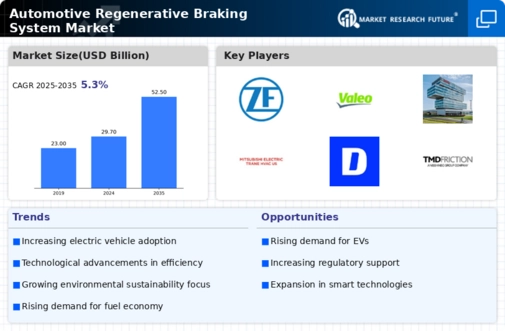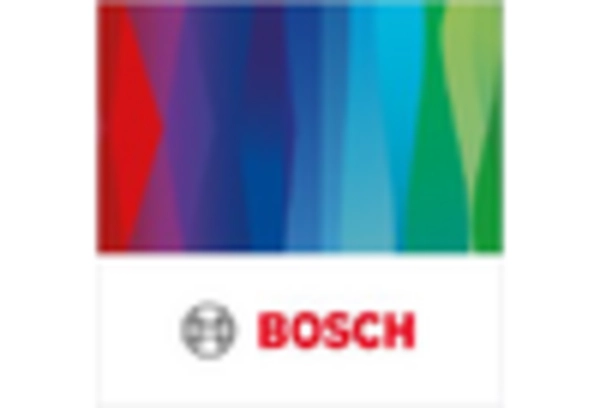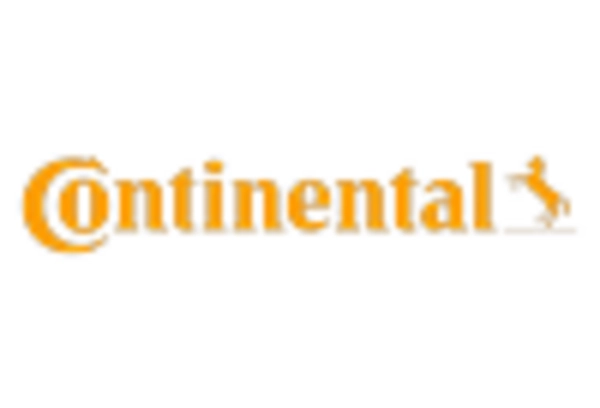Advancements in Battery Technology
Advancements in battery technology are playing a crucial role in the Automotive Regenerative Braking System Market. As battery efficiency improves, the effectiveness of regenerative braking systems is enhanced, allowing for greater energy recovery and storage. Innovations such as solid-state batteries and improved lithium-ion technologies are expected to increase the range and performance of electric vehicles, making them more appealing to consumers. This, in turn, drives the demand for regenerative braking systems, as they are integral to maximizing the benefits of these advanced batteries. The synergy between battery advancements and regenerative braking technologies is likely to create a robust market environment, with projections indicating a steady increase in the adoption of these systems in the automotive sector.
Government Regulations and Incentives
The Automotive Regenerative Braking System Market is also shaped by government regulations and incentives aimed at promoting sustainable transportation solutions. Many countries are implementing stringent emissions standards and offering financial incentives for the adoption of electric and hybrid vehicles, which often incorporate regenerative braking systems. For example, regulations in various regions mandate a reduction in carbon emissions, pushing manufacturers to innovate and adopt technologies that enhance vehicle efficiency. These regulatory frameworks not only encourage the development of regenerative braking systems but also create a favorable market environment for their adoption. As a result, the Automotive Regenerative Braking System Market is likely to benefit from increased investments in research and development, leading to more advanced and efficient braking technologies.
Consumer Awareness and Environmental Concerns
Consumer awareness regarding environmental issues is a pivotal driver for the Automotive Regenerative Braking System Market. As individuals become more informed about the impact of traditional vehicles on the environment, there is a growing preference for vehicles equipped with regenerative braking systems. These systems contribute to reduced energy consumption and lower emissions, aligning with the values of environmentally conscious consumers. Market Research Future indicates that a significant percentage of consumers are willing to pay a premium for vehicles that offer enhanced sustainability features, including regenerative braking. This shift in consumer behavior is likely to encourage manufacturers to prioritize the integration of regenerative braking technologies in their vehicles, thereby fostering growth within the Automotive Regenerative Braking System Market.
Rising Demand for Electric and Hybrid Vehicles
The Automotive Regenerative Braking System Market is significantly influenced by the rising demand for electric and hybrid vehicles. As consumers increasingly prioritize sustainability and fuel efficiency, manufacturers are compelled to integrate regenerative braking systems into their vehicle designs. This trend is underscored by data indicating that electric vehicle sales have surged, with projections estimating that by 2025, electric vehicles could account for nearly 30% of total vehicle sales. Regenerative braking systems play a crucial role in enhancing the overall efficiency of these vehicles by recapturing energy that would otherwise be lost during braking. Consequently, the growing adoption of electric and hybrid vehicles is expected to drive the demand for advanced regenerative braking technologies, thereby propelling the Automotive Regenerative Braking System Market forward.
Technological Innovations in Automotive Regenerative Braking Systems
The Automotive Regenerative Braking System Market is experiencing a surge in technological innovations that enhance the efficiency and effectiveness of regenerative braking systems. Advanced materials and sophisticated algorithms are being integrated into these systems, allowing for improved energy recovery during braking. For instance, the incorporation of lightweight materials reduces overall vehicle weight, thereby increasing the efficiency of energy recovery. Furthermore, the development of smart braking systems that utilize artificial intelligence is likely to optimize performance by predicting braking patterns and adjusting accordingly. This technological evolution not only boosts the performance of electric and hybrid vehicles but also aligns with the growing consumer demand for more efficient automotive solutions. As a result, the market is projected to witness substantial growth, with estimates suggesting a compound annual growth rate of over 10% in the coming years.


















Leave a Comment